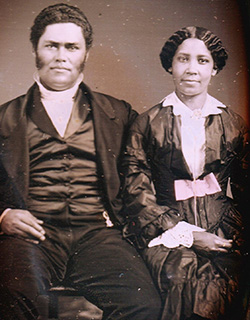When Illinois lawmakers passed a bill barring free Blacks from migrating into the state in 1853, Black residents got busy organizing a statewide protest.
A new digital exhibit by Northwestern University scholars profiles the lives of 25 Black men and women who were active in the struggle for racial justice in 19th-century Illinois. They responded to Illinois' most oppressive Black law by organizing the first statewide political gathering of Black Illinoisans in 1853. They also pressed renowned abolitionist Frederick Douglass to convene a new national convention to discuss the perilous situation of Black people in the U.S.
The exhibit, "Black Organizing in Pre-Civil War Illinois: Creating Community, Demanding Justice," launches Feb. 16. The exhibit will live on Penn State University's Colored Conventions Project website, which preserves the records of seven decades of early Black convention organizing and features interactive historical exhibits documenting what was then called the Colored Convention movement.
People may think of Illinois as a free state from the start and the 'Land of Lincoln.' They may imagine that African Americans didn't have a significant presence here until the Great Migration. This exhibit tells us something quite different."
Northwestern's exhibit is the culmination of a two-year research project led by Kate Masur, professor of history and Board of Visitors Professor at Weinberg College of Arts and Sciences.
The research and creation team included student researchers, and support from digital humanities librarian Josh Honn of Northwestern Libraries and Media and Design Studio director Matthew Taylor of Weinberg.
"People may think of Illinois as a free state from the start and the 'Land of Lincoln,'" Masur said. "They may imagine that African Americans didn't have a significant presence here until the Great Migration. This exhibit tells us something quite different."
Building community, fighting for justice
The exhibit's two themes are community building and fighting for justice. The churches and schools African Americans created in Alton, Springfield, Galena, Chicago and other locales enabled Black settlers to find support and put down roots at a time when many state and local policies were stacked against them.
Focused on the periods before, during and after the historic 1853 convention, the exhibit includes interactive maps that show where Illinois' earliest Black residents settled and the locations of Underground Railroad safe houses in Chicago.
Masur believes many will be surprised by the stories in the exhibit.
Women, such as Mary Richardson Jones, sustained their communities - caring for relatives, fundraising for churches, welcoming fugitive slaves into their home and creating educational opportunities for their children.
Local community institutions were the foundation for political organizing.
"Barring Black migration into the state imperiled the lives of Black people in other places," said Mikala Stokes, a doctoral candidate in the history department and one of the project's student researchers.

"Illinois' 1853 Black law barred African American migrants from enjoying the same freedom of movement that many people in this era held as one of the founding ideals of America. Like most migrants, African Americans moved to new communities to build a better life for themselves and future generations," Stokes said.
"At this point, Illinois was less populated than some of the eastern states and presented an attractive opportunity for the formerly enslaved, fugitive slaves and people who were legally free to come and settle. The pernicious part of the law is that those who crossed state lines could be fined. If they couldn't pay the fine, someone else could, but would then have a right to your labor to pay off the fine. In a slave-holding republic, this prospect of temporary forced labor looked a lot like slavery. This law is one of many examples of how slavery imperiled the lives of all African Americans."
Hope McCaffrey, a graduate student in the history department, also worked on the project.
"One aspect of this research that surprised me was just how wide the scope of these activists' lives were both geographically and regarding their organizing. The range of issues they tackled was immense: fighting for schools and education, civil rights, emancipation, working the Underground Railroad and advocating for women's rights were just a handful of the causes these organizers fought for throughout the course of their lives," McCaffrey said.
One issue of concern to antebellum activists that resonates today is education.
"In antebellum Illinois, a formal education presented an opportunity to learn a trade and make a sufficient living," said Marquis Taylor, a doctoral student in history.
"Black activists often protested the local courts' decision to exclude Black children from public schools. They tied economic empowerment to larger ambitions about achieving equality for Black people. Of course, there are nuances in our contemporary understanding of education's purpose, but I think by and large people view education as fulfilling a similar meaning as earlier Black activists. Today's activists challenge the public education system for perpetuating education inequality - particularly in majority Black schools," Taylor said.
Project launch celebration
Northwestern's Alice Kaplan Institute for the Humanities will host a project launch celebration featuring a panel discussion with exhibit developers Emiliano Aguilar, Lia Davis, Josh Honn, Valeria Lira-Ruelas, Kate Masur, Hope McCaffrey, Shira Nash, Mikala Stokes, Marquis Taylor and Matt Taylor.






